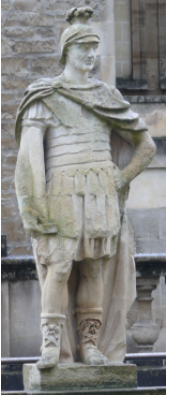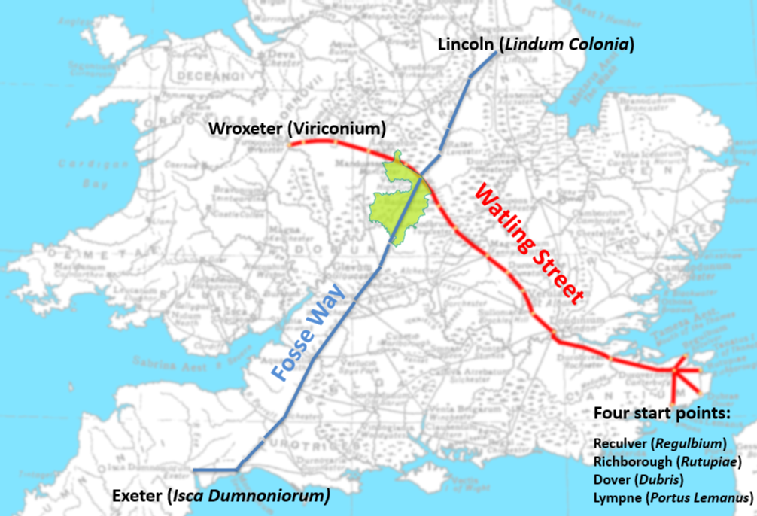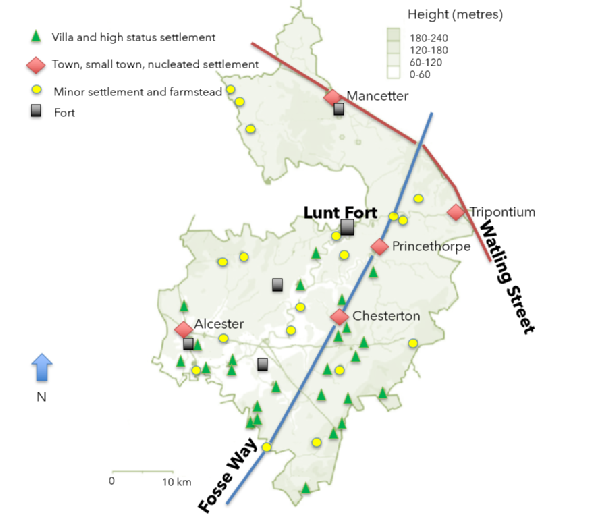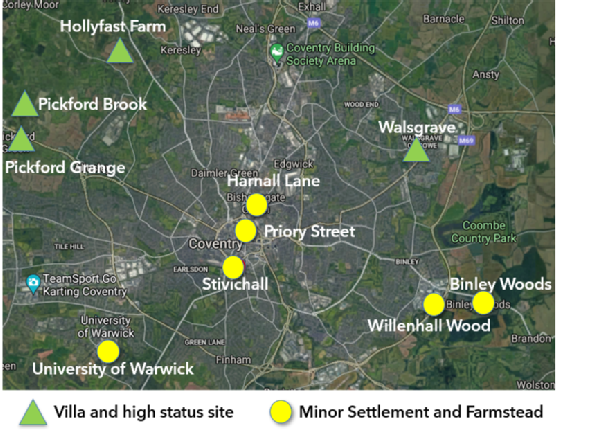The Romans arrive in Warwickshire
Arrival and Conquest
The Romans invaded Britain a number of times starting with Julius Caesar’s first landing in Kent in 55BC. In AD 43 the Romans once again arrived under the emperor Claudius and set about making their mark.
The area of modern day Warwickshire was already inhabited by Iron Age tribes, most probably people affiliated with the Dobunni in the south and west, and the Corieltauvi to the north and east.

We hear of the occupation of the area (in fact of the whole country to the Avon and Severn in the west) from the historian Tacitus, who tells us:
"Ostorius, well aware that first events are those which produce alarm or confidence, by a rapid movement of his light cohorts, cut down all who opposed him, pursued those who fled, and lest they should rally, and so an unquiet and treacherous peace might allow no rest to the general and his troops, he prepared to disarm all whom he suspected, and to occupy with encampments the whole country to the Avon and Severn …" (Tacitus, Annals 12.31)
Ostorius here refers to Publius Ostorius Scapula (left - a statue of him from the Romans baths at Bath) who in the winter of AD47 was appointed the second governor of Roman Britain by the emperor Claudius, suceeding the first governor Aulus Plautius.
In the West Midlands as elsewhere, the first action of the Roman army was that of conquest, with the Romans wishing to pass swiftly through the region to crush the resistance led by Caratacus in Wales and to occupy Britain up to the frontier made by the rivers Mersey and Humber where the Brigantes - a client kingdom - lived (see Mattingley 2006, 83). So while the Roman military presence in the West Midlands region was initially large, its duration was short. The history of occupation at Lunt Fort for example shows an initial period of activity followed by a period when the fort may not have been in use. In this initial period the presence of the army played a huge part in cementing relations with the local Iron Age inhabitants of the region, especially in the transition from rule by these independent peoples in the mid-first century AD to being an integrated part of the Roman province that emerged two or three generations later. With little known resistance, the tribes of Warwickshire settled into becoming civitates or client Kingdoms of the Romans.
The Roman historian Cassius Dio (ca.AD155-235) in his Roman History gives a tantalising possible glimpse into the events of the Roman invasion and their effect on the tribes of this region. As he states in Book 60.20:
[Aulus] Plautius, accordingly, had a deal of trouble in searching them [the Britons] out; but when at last he did find them, he first defeated Caratacus and then Togodumnus, the sons of Cynobellinus, who was dead. (The Britons were not free and independent, but were divided into groups under various kings.) After the flight of these kings he gained by capitulation a part of the Bodunni, who were ruled by a tribe of the Catuellani; and leaving a garrison there, he advanced farther and came to a river.
It seems that Dio Cassius' Bodunni may be the tribe we know as the Dobunni, who occupied the southern part of modern Warwickshire. What we can read into their supposed subservience to the Catuellani (Catuvellauni) is unclear, but what may be recorded here is the moment when the Dobunni accepted the status of client Kingdom of the Romans, thus avoiding the horrific consequences of continued rebellion. This attitude of the locals and their rulers will have been crucial in determining the Roman response to them. Where there was acquiescence - as seems to have been largely the case in the West Midlands following the disarmament of the tribes either by Plautius (if you believe Dio) or by Publius Ostorius Scapula (accepting Tacitus' report) - Roman control was maintained with a light touch. But any resistance was brutally dealt with.
Despite the light touch, there would have been demands on the population and the local economy especially to supply the army garrisoned in local forts, with cattle and their by-products of meat and leather likely to have been the most important.
Warwickshire at the Crossroads
The creation of the road system and the foundation of the network of forts and fortress we see throughout Roman Britain were doubtless interlinked. The roads allowed the rapid movement of troops in times of crises, as demonstrated in their use by Roman forces in the Boudican revolt of AD 60–1, and you can see the forts running along the west side of the Fosse Way in the map on Roman Warwickshire further down the page. Following this initial military use, the roads continued to function as infrastructure.

As shown in the map above, Warwickshire stands at the crossroads of two of the most important Roman roads in Britain, the Fosse Way and Watling Street. Watling Street ran from four separate points on the southeast coast - Reculver (Regulbium), Richborough (Rutupiae), Dover (Dubris) and Lympne (Portus Lemanus) - which converged at Canterbury (Durovernum) before crossing the Thames and running all the way to Wroxeter (Viriconium) in modern day Shropshire. The Fosse Way joined Exeter (Isca Dumnoniorum) in the southwest with Lincoln (Lindum Colonia) in the northeast, crossing as it did the entire future county of Warwickshire. It is possible that the convergence of the two roads may have been important in the Roman victory over Boudica, and if we are looking for a possible location of her defeat, it might be that x marks the spot. In addition, we may view the Fosse Way as something of a line representing the extent of the Romans' first advance into Britain. The Roman Roads remain the most visible legacy of the Roman conquest.
The Roman Army in Warwickshire
A number of sites in Warwickshire show signs of military activity, with three especially - Mancetter, Baginton (the Lunt) and Alcester - demonstrating , a high degree of military activity during the conquest period and later. In Mancetter, occupation may date to the early AD 50s, and a similar sequence may have been followed at Baginton, where early military activity might have been focused at Home Farm, some 250 m to the south of the well-known sequence of forts at The Lunt. The Lunt is close to the junction of the Fosse Way and Watling Street (see map above) and this whole area appears to have been a highly militarised zone with forts at Wall (Letocetum), Mancetter (Manduessedum), Alcester (Alauna) and Metchley. Tacitus recorded that the whole army was kept mobilised during the winter to quell any remnants of the Boudican uprising, and coins from the Lunt suggest its establishment after the defeat of Boudica in AD 60. A later settlement is found at Baginton though how this was related to the fort is unclear.
Military command of the entire West Midland region may have been housed at Chester (Deva) and the forts throughout Warwickshire seem to have been occupied and not at various times, with the assumption that the military threat from this region was perceived to be very low.
Roman Settlements in Warwickshire

By the end of the Iron Age it appears that there were no certain nucleated settlements (larger settlements clustered around a central point) in the region, with none of the known hillforts demonstrably revealing continued occupation at this time. Whether this is evidence of absence or absence of evidence is unclear, but there seem to have been no major Iron Age settlements of note at the time that the Romans arrived. Smaller sites however no doubt existed and continued occupation of these settlements doubtless occurred.
The appearance of forts and the military road system on the Iron Age landscape was followed by the establishment in the first century AD of the first new settlements without Iron Age antecedents, some of which lay on or close to a Roman road.
As can be seen from the map (left), when the Romans came to occupy the county, their settlement revealed a clear pattern of greater occupation in the southern part of the region, with villas clustering around Alcester and Chesterton. And it was Alcester that developed into the principle nucleated settlement of the Roman period in the county. Other nucleated sites at Tripontium, Mancetter, High Cross, Princethorpe, Chesterton and Tiddington have not been studied in as much detail. The peak time of prosperity in the region was from late Second to the Third Century AD, peaking at 200AD.
Roman Settlements in Coventry

Though Coventry was not itself the site of an important settlement during Roman times, this does not mean that it was unoccupied (see for example the Roman Coventry A-Z).
As can be seen from the map on the left, the area surrounding the present day city centre housed a number of villas and high status sites, while the city centre housed some smaller minor settlements or farmsteads.
Roman objects such as pottery, a third-century coin, a toilet set, a bronze ring, a jet ring and other metal items found in the bed of the River Sherbourne at Cox Street may indicate a crossing point. Roman pottery, tile and tesserae (the small cubes used to construct mosaics) were found at Walsgrave, with Roman building material also found at three sites in Allesley. Possible bricks and tesserae and ceramic building material were discovered at Hollyfast Farm, and at Pickford Grange Farm a small quantity of pottery, together with tegulae and tesserae, were uncovered. At Pickford Brook there were tesserae and other Roman building materials, as well as pottery including mortaria and greyware. At all four of these sites, the presence of tesserae suggests a high status settlement, potentially villas.
What were these new settlements like? Excavated evidence suggests a focus on stock-rearing, replacing the mixed farming practise of the Iron Age. Farmsteads spaced about a kilometre apart lay in an extensively managed landscape of enclosed fields and paddocks, heathland, grassland, wood pasture and probably woodland managed as coppice. Whether the animals raised were cattle, sheep or horses, each were meeting the demands of consumers through markets at places like Alcester and possibly also to supply military garrisons to the north and west.
For more information, read the excellent 'Clash of Cultures?: The Romano-British Period in the West Midlands: 3 (The Making of the West Midlands)' edited by 2018.
